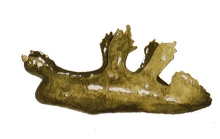
| Introduction | | Search taxa | | Taxon tree | | Taxon match | | Checklist | | Literature | | Stats | | Photogallery | | OBIS Vocab | | Log in |
CaRMS taxon detailsScyllaea pelagica Linnaeus, 1758
141425 (urn:lsid:marinespecies.org:taxname:141425)
accepted
Species
marine
Linnaeus, C. (1758). Systema Naturae per regna tria naturae, secundum classes, ordines, genera, species, cum characteribus, differentiis, synonymis, locis. <em>Editio decima, reformata [10th revised edition], vol. 1: 824 pp. Laurentius Salvius: Holmiae.</em> , available online at https://biodiversitylibrary.org/page/726886 [details] Available for editors
Description Chunky body, up to 6 cm long, with the mantle ridge bearing a line of brown pigment and one or two pairs of irregularly...
Description Chunky body, up to 6 cm long, with the mantle ridge bearing a line of brown pigment and one or two pairs of irregularly squared cerata which have gills on their inner surfaces. The rhinophores emerge from elongated sheaths. Habitat: lives and feeds on hydroids among the seaweed Sargassum; often washed up on the shore with floating weed. Distribution: pantropical. [details] Distribution Massachusetts to the West Indies
Distribution Massachusetts to the West Indies [details]
MolluscaBase eds. (2021). MolluscaBase. Scyllaea pelagica Linnaeus, 1758. Accessed through: Nozères, C., Kennedy, M.K. (Eds.) (2021) Canadian Register of Marine Species at: http://www.marinespecies.org/CaRMS/aphia.php?p=taxdetails&id=141425 on 2024-04-23
Nozères, C., Kennedy, M.K. (Eds.) (2024). Canadian Register of Marine Species. Scyllaea pelagica Linnaeus, 1758. Accessed at: https://marinespecies.org/carms/aphia.php?p=taxdetails&id=141425 on 2024-04-23
Date action by
original description
Linnaeus, C. (1758). Systema Naturae per regna tria naturae, secundum classes, ordines, genera, species, cum characteribus, differentiis, synonymis, locis. <em>Editio decima, reformata [10th revised edition], vol. 1: 824 pp. Laurentius Salvius: Holmiae.</em> , available online at https://biodiversitylibrary.org/page/726886 [details] Available for editors
context source (Bermuda) Jensen, R. H. (1997). A Checklist and Bibliography of the Marine Molluscs of Bermuda. Unp. , 547 pp [details] basis of record Gofas, S.; Le Renard, J.; Bouchet, P. (2001). Mollusca. in: Costello, M.J. et al. (eds), European Register of Marine Species: a check-list of the marine species in Europe and a bibliography of guides to their identification. <em>Patrimoines Naturels.</em> 50: 180-213., available online at http://www.vliz.be/imisdocs/publications/ocrd/254404.pdf [details] additional source Rosenberg, G. 2004. Malacolog Version 3.3.2: Western Atlantic gastropod database. The Academy of Natural Sciences, Philadelphia, PA., available online at http://www.malacolog.org [details] additional source Rosenberg, G.; Moretzsohn, F.; García, E. F. (2009). Gastropoda (Mollusca) of the Gulf of Mexico, Pp. 579–699 <i>in:</i> Felder, D.L. and D.K. Camp (eds.), Gulf of Mexico–Origins, Waters, and Biota. Texas A&M Press, College Station, Texas. [details] Available for editors additional source Liu, J.Y. [Ruiyu] (ed.). (2008). Checklist of marine biota of China seas. <em>China Science Press.</em> 1267 pp. (look up in IMIS) [details] Available for editors additional source Pola M., Camacho-Garcia Y.E. & Gosliner T.M. (2012) Molecular data illuminate cryptic nudibranch species: the evolution of the Scyllaeidae (Nudibranchia: Dendronotina) with a revision of <i>Notobryon</i>. <i>Zoological Journal of the Linnean Society</i> 165: 311–336., available online at http://onlinelibrary.wiley.com/doi/10.1111/j.1096-3642.2012.00816.x [details] Available for editors  Present Present  Inaccurate Inaccurate  Introduced: alien Introduced: alien  Containing type locality Containing type locality
From other sources
Description Chunky body, up to 6 cm long, with the mantle ridge bearing a line of brown pigment and one or two pairs of irregularly squared cerata which have gills on their inner surfaces. The rhinophores emerge from elongated sheaths. Habitat: lives and feeds on hydroids among the seaweed Sargassum; often washed up on the shore with floating weed. Distribution: pantropical. [details]Distribution Massachusetts to the West Indies [details]
Encyclopedia of Marine Life of Britain and Ireland
To Barcode of Life (11 barcodes) To Biodiversity Heritage Library (97 publications) To Biological Information System for Marine Life (BISMaL) To European Nucleotide Archive (ENA) To GenBank (12 nucleotides; 8 proteins) To PESI To Sea Slug Forum (via archive.org) To USNM Invertebrate Zoology Mollusca Collection To ITIS |
